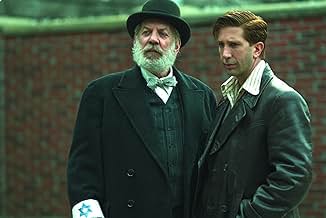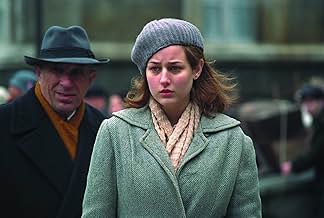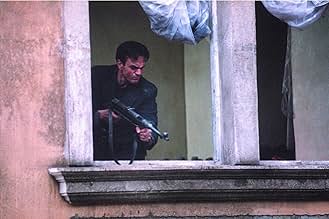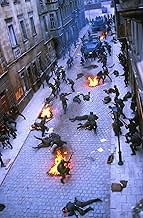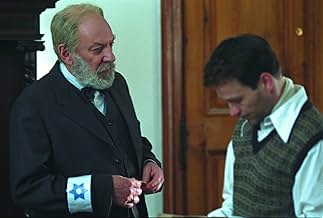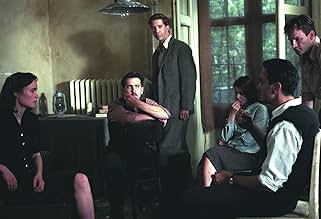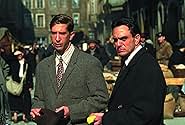NOTE IMDb
7,2/10
5,3 k
MA NOTE
Ajouter une intrigue dans votre langueJews rise up in the Warsaw Ghetto against the Nazis in 1943.Jews rise up in the Warsaw Ghetto against the Nazis in 1943.Jews rise up in the Warsaw Ghetto against the Nazis in 1943.
- Réalisation
- Scénario
- Casting principal
- Récompensé par 1 Primetime Emmy
- 5 victoires et 17 nominations au total
Avis à la une
A civilian step to four or five german soldiers with a handgun,he shoots with one hand while walking! Guess who won the the pistol vs machineguns duel? The civilians killed them all!Even a trained S.W.A.T man can not do that. This kind of stuff could be OK in a John Woo film, but is inacceptable in a half-documentary war movie, this kind of action scenes may be fun for some audiences but also ruined the whole movie.
In 1939, after the invasion of Poland, Reinhard Heydrich chief of Gestapo began to place all Polish Jews in ghettos, where they could slowly die of hunger and disease. The campaign was to be administered by the Waffen-SS the party's military formations that fought as integral units in the armed forces. The Warsaw ghetto was the largest of these segregated areas established by the Nazis in Poland. In 1940 Heydrich, using the excuse that the spread of typhus had to be contained, set up a special section 11 miles in circumference enclosed by a brick wall 10 feet high . The cost was paid by the Judenrat (whose leader named Adam Czerniakow is perfectly played by Donald Sutherland) , the Jewish Council of twenty-four-members, which was in charge of Jewish affairs inside the ghetto . The daily struggle against hunger and disease is aggravated by the German demands for "deportations to the east" that many begin to suspect are camouflaged mass murders . Later on , there takes place the upheaval by a handful of fighters .
This is an emotionally tale and very decent drama about a group of Jews from uprising until terrible ending in the Warsaw ghetto . Jon Avnet correctly directs a spellbinding portrait about the holocaust with intense drama , action and spectacular as well as sad scenes . A splendid all-star-cast gives magnificent acting in real-life characters such as Leelee Sobieski as Tosia Altman , David Schwimmer as Yitzhak Zuckerman , Stephen Moyer as Kazik Rotem, Sadie Frost as Zivia Lubetkin , Radha Mitchell as Mira Fruchner , Mili Avital as Deworah Baron and special mention to Hanz Azaria who is excellent in a complicate and suffering role . An of course , we can not forget the great John Voight as Major-General Jurgen Stroop who carried out the brutal repression . Emotive as well as sensitive musical score by the classical Maurice Jarre . Impressive and adequate production by the Spanish Benjamin Fernandez who previously had designed ¨The others¨ and ¨Daylight¨ . Evocative and atmospheric cinematography by cameraman Denis Lenoir .
Adding more details over largely described on the movie regarding 'the Warsaw ghetto uprising', the events happened on the following manner : From 300 to 400 died daily in the Warsaw trap. More than 43.000 starved to death during the first year. Children crazed by hunger crawled through the sewers to the non-Jewish sectors of the city to smuggle in a bit of food. People were no longer moved by the sight of men and women falling dead on the streets. The Nazi authorities began intensified measure on July 22, 1942. As a memorial to Heydrich, Heirich Himmler ordered all Jews except those already in concentration camps to be deported .The ghetto and all labor camps would then be destroyed. Mass deportations to the gas chambers of Treblinka began. In two months 300.000 Jews were eliminated. The Judenrat was ordered to deliver 6.000 Jews daily for deportation. Each day thousands were driven by guards through the gates.Young Zionists, pioneers training to go to Palestine, mobilized first to be followed by members of the Polish workers party . On July 28, 1942, the Jewish Combat organization consisting about 1.000 men and boys was formed. All resolved to kill as many of their tormentors as they could before they died.The Jews fighting from rooftops, cellars, and attics,Poles outside the ghetto now began to send in more revolvers, grenades, and dynamite. In 1943 the guerrillas divided into twenty-two groups built an intricate network underground cellars and tunnels ,linked with command posts . In April 19,1943 German troops moved in on the ghetto to send all who were left to Treblinka in a final action. First came the armed trucks, tanks, and armored cars. The ghetto fighters poured a hail of bullets, grenades and bombs, the fighting went on for twenty-eight days. The guerrillas fought to the last . Many committed suicide at the moment before capture. The Germans dragged survivors from the cellars and rubble. Fewer than 100 escaped, the last 60000 Jews had been exterminated or killed in the explosions and fires.Polish sources reported that the fighters had killed 300 Germans and wounded 1000. From Warsaw Jewish resistance moved to swamps and forests .
This is an emotionally tale and very decent drama about a group of Jews from uprising until terrible ending in the Warsaw ghetto . Jon Avnet correctly directs a spellbinding portrait about the holocaust with intense drama , action and spectacular as well as sad scenes . A splendid all-star-cast gives magnificent acting in real-life characters such as Leelee Sobieski as Tosia Altman , David Schwimmer as Yitzhak Zuckerman , Stephen Moyer as Kazik Rotem, Sadie Frost as Zivia Lubetkin , Radha Mitchell as Mira Fruchner , Mili Avital as Deworah Baron and special mention to Hanz Azaria who is excellent in a complicate and suffering role . An of course , we can not forget the great John Voight as Major-General Jurgen Stroop who carried out the brutal repression . Emotive as well as sensitive musical score by the classical Maurice Jarre . Impressive and adequate production by the Spanish Benjamin Fernandez who previously had designed ¨The others¨ and ¨Daylight¨ . Evocative and atmospheric cinematography by cameraman Denis Lenoir .
Adding more details over largely described on the movie regarding 'the Warsaw ghetto uprising', the events happened on the following manner : From 300 to 400 died daily in the Warsaw trap. More than 43.000 starved to death during the first year. Children crazed by hunger crawled through the sewers to the non-Jewish sectors of the city to smuggle in a bit of food. People were no longer moved by the sight of men and women falling dead on the streets. The Nazi authorities began intensified measure on July 22, 1942. As a memorial to Heydrich, Heirich Himmler ordered all Jews except those already in concentration camps to be deported .The ghetto and all labor camps would then be destroyed. Mass deportations to the gas chambers of Treblinka began. In two months 300.000 Jews were eliminated. The Judenrat was ordered to deliver 6.000 Jews daily for deportation. Each day thousands were driven by guards through the gates.Young Zionists, pioneers training to go to Palestine, mobilized first to be followed by members of the Polish workers party . On July 28, 1942, the Jewish Combat organization consisting about 1.000 men and boys was formed. All resolved to kill as many of their tormentors as they could before they died.The Jews fighting from rooftops, cellars, and attics,Poles outside the ghetto now began to send in more revolvers, grenades, and dynamite. In 1943 the guerrillas divided into twenty-two groups built an intricate network underground cellars and tunnels ,linked with command posts . In April 19,1943 German troops moved in on the ghetto to send all who were left to Treblinka in a final action. First came the armed trucks, tanks, and armored cars. The ghetto fighters poured a hail of bullets, grenades and bombs, the fighting went on for twenty-eight days. The guerrillas fought to the last . Many committed suicide at the moment before capture. The Germans dragged survivors from the cellars and rubble. Fewer than 100 escaped, the last 60000 Jews had been exterminated or killed in the explosions and fires.Polish sources reported that the fighters had killed 300 Germans and wounded 1000. From Warsaw Jewish resistance moved to swamps and forests .
I always have very low expectations of made for TV movies as they tend to be poor in comparison to feature films. But this one actually impressed me. The focus of the film was not the entire holocaust, but it focused on the Warsaw ghetto uprising of the Jews (the previous reviewer might have saved themselves some trouble had they simply read that beforehand) so the writing and characters were focused and good and it was all based on true people and events. The sets were well-constructed. I had forgotten I was watching a TV movie. A good cast. Good acting. Much of the cast was unknown, most of them not even Jewish. Donald Sutherland and Cary Elwes gave outstanding performances as did John Voight. Definitely worth viewing. Many good extras on the DVD as well.
I saw this film in Australia with a relative who survived the Ghetto uprising. He said that, in spite of some inconsistencies, it was as accurate as film could portray it. While it is true that there was more than one resistance faction, and sometimes they were at odds, the essence of the event is portrayed well. The Polish Resistance's attitude was mixed, but my relative, who was a courier in and out of the Ghetto said that many individual Poles risked their lives to hide him. The woman who escaped with the baby at the end of the film is also related to me. Her husband, who was killed in the first days of the uprising, was a major planner and organizer. Of course, it affected me greatly since my mother originally came from Warsaw and I lost many relatives.
On the night the Emmys awarded "Anne Frank" the best miniseries of 2000-2001, NBC began airing yet another WWII-era epic which has to be the odds-on favorite for the trophy next year. This is as fine a miniseries as I have ever seen. David Schwimmer, Leelee Sobieski and Hank Azaria are all highly believable in their roles as Jewish resistance fighters. Donald Sutherland and Jon Voight turn in fine performances in lesser roles. And director Jon Avnet delivers a compact, credible piece of little-known history regarding the Warsaw ghetto uprising. For a small screen effort, one has to be amazed at how closely the style resembles that of big screen efforts like "Saving Private Ryan" and "Schindler's List". All in all, a well-done miniseries that deserves a second viewing. How often can one say that about any miniseries.
Le saviez-vous
- AnecdotesFinal credited project of composer Maurice Jarre.
- GaffesHistorically, the "tanks" used by the Germans during the suppression of the uprising were actually French light assault guns Lorraine 37L - which means there was not a single Tiger tank (not to mention two). Also, the SS troops were "police" and training/reserve units (rear formations), not the front-line troops.
- Citations
Mordechai Anielewicz: Can a moral man, that's me, maintain his moral code in an immoral world?
- Versions alternativesR1 DVD runs 177'15" (NTSC), but European releases only 152'28" (PAL) (a difference of almost 18'26" allowing for the different frame rates).
- ConnexionsEdited into Resistance (2001)
- Bandes originalesPiano Sonata No. 14 in C sharp minor, Op. 27 No. 2 'Moonlight'
Written by Ludwig van Beethoven
Performed by Sympho Inc. Studio Orchestra (Bratislava, Slovenia)
Meilleurs choix
Connectez-vous pour évaluer et suivre la liste de favoris afin de recevoir des recommandations personnalisées
Détails
Box-office
- Montant brut mondial
- 9 266 $US
- Durée
- 2h 57min(177 min)
- Couleur
- Mixage
- Rapport de forme
- 1.85 : 1
Contribuer à cette page
Suggérer une modification ou ajouter du contenu manquant

